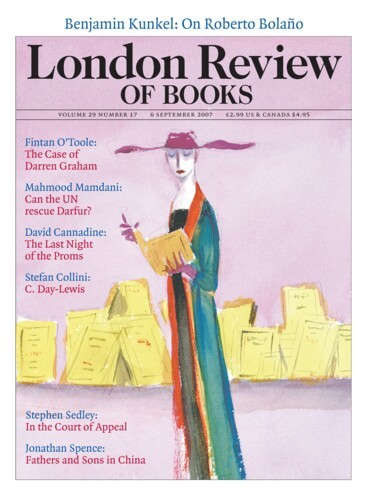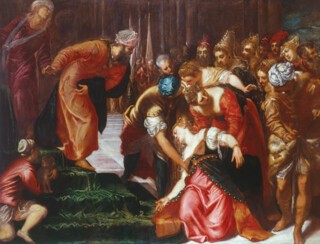Much of what is on show in the Queen’s Gallery until 20 January has been in the Royal Collection for a very long time. Charles I himself very probably commissioned one of the most remarkable pictures, Orazio Gentileschi’s Joseph and Potiphar’s Wife. Although the paintings Charles had gathered together were efficiently dispersed at auction under the Commonwealth (a few were kept by Parliament, in particular the Raphael cartoons and Mantegna’s Triumph of Caesar), many were retrieved at the Restoration, with almost equal efficiency. Some of the greatest pictures had been sold abroad but as the notes on provenance in the catalogue show, there was much to be recovered (not always ungrudgingly) from English hands. And a lot more was added by later monarchs. However, pictures the catalogue notes as being ‘recovered at the Restoration’ include many of the finest things in The Art of Italy in the Royal Collection: Renaissance and Baroque. They include the Caravaggio Calling of Saints Peter and Andrew, the two Tintorettos (Esther before Ahasuerus and The Muses) and the two Bassanos (The Adoration of the Shepherds and The Journey of Jacob); the Lovers attributed to Titian, the Correggio Holy Family, the Bronzino Portrait of a Lady in Green, the two paintings by Gentileschi – A Sibyl is the other one – and his daughter Artemisia’s self-portrait. Without these the exhibition would be significant; with them it is magnificent.
As well as paintings there are rooms of drawings. A few, like Michelangelo’s Fall of Phaeton and A Children’s Bacchanal, were presentation pieces, and thus ends in themselves. They are notable inventions – no pose is repeated and the falling horses make an astonishing tangle of limbs, heads and bodies – but the perfection of hatching and shading precludes spontaneity. Most show how ideas were represented, poses recorded, invented and explored, and groupings arrived at. These too are remarkable. Some painters drew a lot, some hardly at all. The catalogue shows how X-rays and other special imaging tools can uncover some of the ways Tintoretto, Caravaggio and Titian sketched beginnings and adjusted work in progress.
The two paintings by Tintoretto are among the very great works in the exhibition. Esther before Ahasuerus (shown here) depicts the moment when Esther, Ahasuerus’s wife, having come to plead for the lives of her Jewish compatriots, faints. Ahasuerus, leaning forward, steps down towards her from his throne. His right arm is extended, the wrist flexed back in a ‘be calm’ or ‘stop, take care’ gesture. The same gesture is made both by the woman who looks over the shoulder of the two maids supporting Esther and by the courtier on the right, who also leans forward as he peers round to see what is going on. All the faces in this central group except Esther’s are in shadow, and are foreshortened or in lost profile. Esther’s pale, strongly lit face and breast first draw your eye, but she too is turned away from you, her face, too, foreshortened. To read emotions – Ahasuerus’s concern, the maids’ anxiety, the courtier’s curiosity, Esther’s obliviousness – you look to the poses and gestures that join the one fallen and the five circling and supporting figures into a single, intertwined group. The linkage does not subtract from their individuality. More information about the expressions on their faces would be a distraction. In the workshop version of the picture reproduced in the catalogue, the whole scene is more evenly lit, the rhythm of linked highlit arms and shoulders lost in the general brightness. The drama dissipates, you no longer think Esther has fainted from fright. Perhaps she is just overcome by the airlessness of a crowded room. The story and the way it is told are as important as they would be in a play.
The Muses is differently magnificent, more like a ballet, where the subject is an occasion rather than the driving force. Nine nude figures, the muses, sit and stand on clouds or float in space-walks across the canvas. The odd flourish of drapery and the unobtrusive attributes – a book, a manuscript, a musical instrument – are subservient to the sumptuous display of strong, pale, muscular bodies derived, it would seem, more from sculpture than from life. Areas of light and shade on their white flesh complicate the rhythm. In Esther before Ahasuerus, light dramatises poses that gather to a climax around the central figure: in The Muses it gives substance to a visual meditation on strong, solid bodies. As in Esther, gestures are more important than faces. Those of the larger foreground figures are in shadow, while the three more distant, snub-nosed sisters present almost identical passive masks.
Sometimes it is faces that tell the story, and sometimes one story lies hidden behind another. A beautiful dark-haired young woman meets your eye challengingly in Cristofano Allori’s Judith with the Head of Holofernes. She grasps her bearded trophy by the forelock. His eyes are closed and his mouth half-open, but he is in his own way as handsome as she is. Her maid, who looks over her shoulder, seems to be wondering whether Judith hasn’t perhaps gone a bit far. According to Allori’s biographer, Judith is a portrait of Maria di Giovanni Mazzafirri, the maid a portrait of her mother, and the head a self-portrait. The whole is a comment on Allori’s unhappy love affair with ‘La Mazzafirra’. She could easily stand in for one of the courtesans you can read about in Aretino’s Dialogues, who leave besotted lovers broken. The catalogue inexplicably twice describes the decapitated head as Goliath’s. But you can see why someone might make that mistake, for you can easily read a boyish defiance into the dark-eyed glance Judith casts towards us.
Gentileschi’s Joseph and Potiphar’s Wife is more subtle. At first glance it is a study in rich stuffs and surfaces. A red curtain, the gold and black coat the importunate wife has torn from Joseph’s shoulders, the blue of her dress, her white flesh, the even whiter sheets and pillow, the tiled floor and gold bed, even the dark red of the retreating Joseph’s tunic are so beautifully rendered that, without the title, you would not guess at the darkness in the scene. It was painted in 1630–32, a couple of years before Rembrandt etched his version, in which the woman displays her nakedness as she twists around, grabbing the garment she will use to accuse Joseph of rape when she has failed to drag him into bed. He departs in an undignified scramble. Gentileschi could be illustrating a different story. His figures are not active; they have the stiffness of figures posed by models. The woman’s face is calm, certainly not ravishing, and could easily be taken from life. In the Bible story she grabs Joseph’s coat. In this scene she could equally well be saying: ‘Here, don’t forget this.’ One can’t guess Gentileschi’s intentions, but the ambiguity of the attitudes the figures take up allows one to make up another story in which Joseph is not quite so prudish and the wife not so avid.
Stories in pictures are worth taking account of. Some are just an excuse, a name to explain things to people who are not able to look at the image in the abstract. Bassano’s beautiful Journey of Jacob, with its camel drivers, shepherdesses, children and their animals interacting in ways that demand no explanation, is a piece of pastoral poetry that would be as captivating without any biblical reference. But look at the Esther or the Judith without knowing what is going on and you lose half the point.
Send Letters To:
The Editor
London Review of Books,
28 Little Russell Street
London, WC1A 2HN
letters@lrb.co.uk
Please include name, address, and a telephone number.


